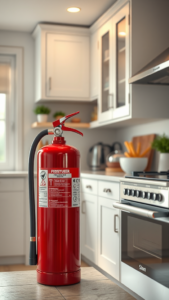The Importance of Having a Fire Extinguisher in Your Home Kitchen
When it comes to your home, safety should always be a top priority, especially in the kitchen. The kitchen is often the heart of the home, but it’s also one of the most dangerous places due to the presence of heat sources, flammable materials, and cooking equipment. Having a fire extinguisher in your kitchen can be a lifesaver in the event of a fire, and understanding why it’s essential can help you take the necessary precautions to protect your family and home.
Fires can start in the kitchen for various reasons, including:
- Cooking accidents, such as unattended stovetops or overheated oil
- Malfunctioning kitchen appliances
- Flammable items too close to heat sources
- Electrical issues that may lead to sparks
With these potential dangers, it’s crucial to be prepared. Here are some key reasons why a fire extinguisher should be a staple in your home kitchen:
Quick Response to Fire
The most significant advantage of having a fire extinguisher readily available is the ability to respond quickly. In the event of a small fire, you have the tools at your fingertips to tackle it before it spreads. Remember, kitchen fires can escalate within minutes, and every second counts. By having a fire extinguisher within reach, you can act quickly to contain the situation.
Prevention of Major Damage
If a small fire is not addressed promptly, it can lead to significant damage to your home. Flames can spread to cabinets, countertops, or even nearby appliances. By putting out a small fire before it grows, you not only save your kitchen but also protect your entire home from extensive fire damage. This can also prevent financial loss associated with home repairs and possessions lost to fire.
Encourages Safe Cooking Practices
Understanding that you have a fire extinguisher in your kitchen can encourage safer cooking practices. Knowing that you are prepared for emergencies can boost your confidence while cooking. You might feel more at ease trying new recipes or cooking methods, knowing you have a safety net. Additionally, it reminds you to remain vigilant while cooking, helping you stay focused and attentive to potential hazards.
Education and Preparedness
Having a fire extinguisher means you will also need to educate yourself and your family about its proper use. This conversation can serve as an excellent learning opportunity. Teach your family members how to operate the extinguisher, including:
- Pulling the pin to break the seal
- Aiming the nozzle at the base of the fire
- Squeezing the handle with firm pressure
- Moving side to side to effectively cover the fire
Regularly reviewing this information can make all the difference in an emergency. With each family member educated, everyone can act quickly, helping to minimize panic during a fire.
Choosing the Right Fire Extinguisher
When it comes to fire extinguishers, not all are created equal. You should choose one specifically rated for kitchen fires. Look for Class K extinguishers, designed to handle fires caused by cooking oils and fats, or Class B extinguishers, suitable for flammable liquids like grease. Always check the label and ensure that it’s suitable for the types of fires you may encounter in the kitchen.
Regular Maintenance
To ensure your fire extinguisher is always ready for use, regular maintenance is essential. This includes:
- Checking the pressure gauge to ensure it’s in the green zone
- Inspecting for any visible signs of damage or leaks
- Recharging or replacing the extinguisher every 5 to 15 years, depending on the manufacturer’s guidelines
By maintaining your fire extinguisher, you increase its reliability, ensuring it’s ready to assist in an emergency.
Placing a fire extinguisher in your home kitchen is a small step that can make a huge difference. It’s not just about having one but ensuring everyone in your home knows how to use it effectively. Being proactive can protect your loved ones and help you enjoy your time cooking without fear of disaster.
Tips for Choosing the Right Fire Extinguisher for Kitchen Safety
Keeping your kitchen safe is essential, and one of the most critical steps is choosing the right fire extinguisher. A fire can start in a heartbeat, especially when cooking, so being prepared can make all the difference. Here are some useful tips to help you select the best fire extinguisher for your home kitchen.
Understand the Classes of Fire Extinguishers
Not all fire extinguishers are created equal. They are designed for different types of fires, classified into several categories:
- A: For ordinary combustibles like wood, paper, and cloth.
- B: For flammable liquids and gases, such as grease, oil, and gasoline.
- C: For electrical fires, involving appliances and wiring.
- K: Specifically for kitchen fires, involving cooking oils and fats.
In the kitchen, where grease fires are common, a Class K extinguisher is particularly crucial. However, having a multi-class extinguisher can also be beneficial, as it handles various fire types.
Consider the Size of the Extinguisher
When selecting a fire extinguisher, size matters. Look for an extinguisher that you can easily handle in an emergency. A compact model typically weighs about 5 to 10 pounds, making it easier to use and store in your kitchen.
Ensure that it’s not too heavy for you to lift if you need to reach it quickly. It’s also wise to choose one that fits neatly under your kitchen sink or in a cupboard, ensuring it’s accessible when needed.
Check the Fire Extinguisher Rating
Fire extinguishers have ratings that indicate their effectiveness. Look for labels that highlight “UL” or “ANSI” certifications. The combination rating, such as “2-A:10-B:C,” signifies that the extinguisher is suitable for Class A, B, and C fires, which enhances its usability in your kitchen.
Ensure you’re aware of the minimum rating required for home use, as it helps determine the extinguisher’s capacity to handle larger fires.
Look for Additional Features
Some fire extinguishers come with added benefits that make them user-friendly. Here are a few features to consider:
- Easy-to-read Instructions: Clear instructions can be life-saving. Look for extinguishers with graphics that guide you through the usage process.
- Metal Handles: A sturdy, metal handle is often more durable than plastic and easier to grip when in panic mode.
- Pressure Gauge: A built-in gauge helps you quickly check if it’s charged or needs servicing.
Regular Maintenance is Key
Owning a fire extinguisher is just the first step; regular maintenance ensures it will function when needed. Check your fire extinguisher monthly for the following:
- Make sure the pressure gauge indicates it’s charged.
- Check for any physical signs of damage or corrosion.
- Inspect the nozzle to ensure it’s clear and unobstructed.
Additionally, it’s advisable to have it serviced once a year by a professional. This will keep it in top condition and extend its lifespan.
Educate Yourself and Your Family
Even with the right fire extinguisher, knowing how to use it is critical. Familiarize yourself and family members with the PASS technique:
- P: Pull the pin.
- A: Aim low at the base of the fire.
- S: Squeeze the handle.
- S: Sweep side to side.
Practicing this method can prepare everyone for an emergency, reducing panic and confusion.
Identify the Best Location for Your Extinguisher
Placement of your extinguisher can significantly impact its effectiveness. Keep it:
- Near the kitchen exit, so you can escape if the fire spreads.
- Out of the reach of children, yet accessible to adults.
- In a spot where it’s visible and easy to grab.
Having the right fire extinguisher in the kitchen is about more than just compliance with safety regulations. It’s about protecting your home, family, and peace of mind. By understanding how to choose the right one for your specific needs, you empower yourself to handle potential kitchen fires more effectively.
Conclusion
Having a fire extinguisher readily available in your home kitchen is not just a precaution—it’s a necessity. The kitchen is often the heart of the home, but it can also be the most vulnerable place when it comes to fire hazards. Whether it’s an unattended pan catching fire or an appliance malfunction, being prepared can make all the difference. By investing in a quality fire extinguisher, you ensure that you are equipped to tackle small fires before they escalate, protecting both your home and your loved ones.
Selecting the right fire extinguisher specifically designed for kitchen safety is crucial. Be aware of the fire classes; for example, a Class K extinguisher is ideal for cooking oils and fats, while a Class B extinguisher handles flammable liquids. It’s essential to choose one that suits your cooking habits and has the appropriate rating for your kitchen environment.
Remember to regularly check the extinguisher and keep it in an accessible location. Familiarize yourself with how to use it effectively, ensuring all household members feel confident in an emergency situation. Safety should be a shared responsibility.
Taking these steps now will help you create a safer cooking environment. Equip your kitchen with the right fire extinguisher and embrace a proactive approach towards kitchen safety. Your preparedness could make a life-saving impact in a moment of crisis.




